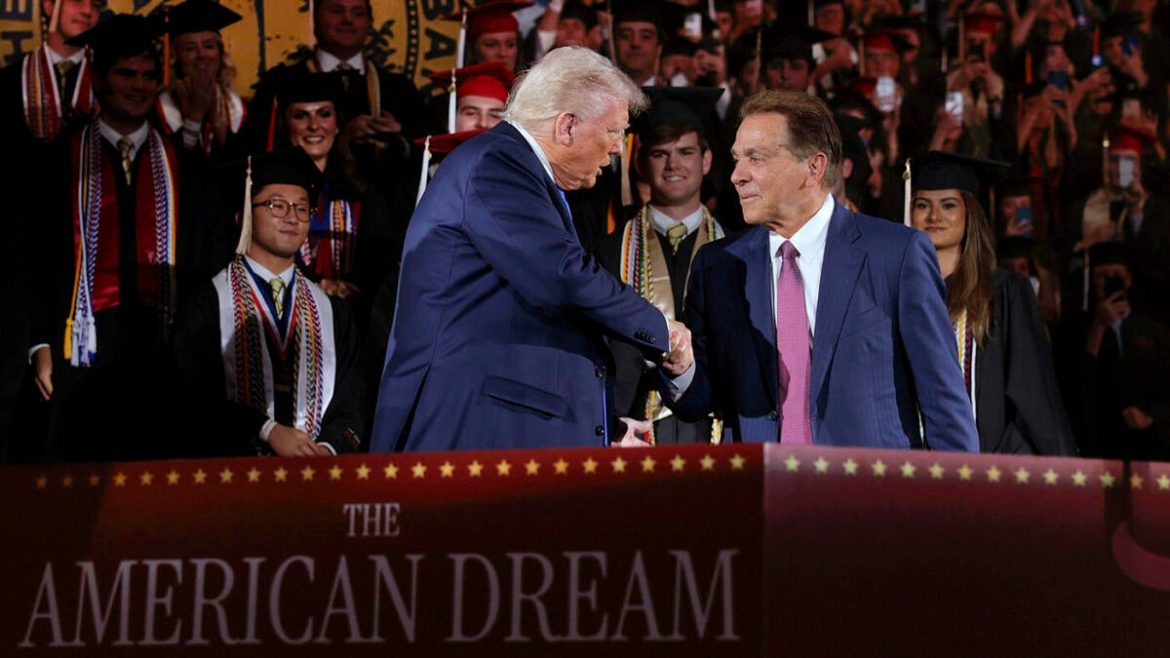The Potential Impact of Trump’s Executive Order on NIL in College Athletics
The landscape of college athletics is on the brink of significant change, as President Donald Trump considers issuing an executive order to regulate Name, Image, and Likeness (NIL) payments. This development comes in the wake of a meeting between President Trump and legendary Alabama coach Nick Saban, a vocal critic of the current NIL framework. The potential executive order could reshape how college athletes are compensated, adding a layer of federal oversight to an area that has seen rapid growth and minimal regulation.
The Meeting and Its Implications
The meeting between President Trump and Nick Saban in Tuscaloosa, Alabama, was more than just a ceremonial event. It marked the beginning of a conversation that could fundamentally alter the future of college athletics. Saban, known for his influential voice in the sports world, expressed his desire to “reform” rather than destroy the NIL system. This nuanced approach suggests that any potential executive order would aim to strike a balance between protecting athletes and maintaining the integrity of college sports.
The Current State of NIL
Since the NCAA’s policy change in 2021, allowing athletes to profit from their NIL, the landscape of college athletics has undergone a seismic shift. Athletes, particularly those in high-profile sports like football and basketball, have secured lucrative deals, often through collectives backed by boosters. While this has provided financial opportunities for athletes, it has also raised concerns about fairness, transparency, and the potential for exploitation.
The Need for Regulation
The rapid expansion of NIL deals has outpaced the development of regulatory frameworks, leading to a Wild West scenario where rules are often unclear and enforcement is inconsistent. This lack of oversight has raised eyebrows among stakeholders, including coaches, administrators, and even some athletes. President Trump’s consideration of an executive order reflects a growing recognition that federal intervention may be necessary to bring order to the chaos.
The Potential Executive Order
While the specifics of the executive order are still under consideration, several key areas are likely to be addressed. These include increased scrutiny of NIL deals, enhanced transparency requirements, and potential limits on the involvement of third-party entities like collectives. The goal would be to create a more equitable and transparent system that benefits athletes without compromising the integrity of college sports.
Increased Scrutiny and Transparency
One of the primary objectives of the executive order could be to increase scrutiny of NIL deals. This would involve establishing clear guidelines for what constitutes a legitimate NIL deal and ensuring that all transactions are transparent and above board. Enhanced reporting requirements could be implemented, mandating that schools and athletes disclose the details of their NIL agreements.
Limits on Third-Party Involvement
The role of third-party entities, such as collectives, has been a contentious issue in the NIL debate. While these groups have provided significant financial support to athletes, they have also been accused of circumventing NCAA rules and creating an uneven playing field. The executive order could impose limits on the involvement of these entities, ensuring that they operate within a clearly defined regulatory framework.
Protecting Athlete Welfare
At the heart of the NIL debate is the welfare of the athletes. Any executive order would need to prioritize the protection of athletes, ensuring that they are not exploited and that their rights are safeguarded. This could involve establishing minimum standards for NIL deals, providing legal protections for athletes, and creating mechanisms for dispute resolution.
The Broader Impact
The potential executive order on NIL payments would have far-reaching implications for college athletics. It could reshape the dynamics of recruiting, alter the balance of power between schools and athletes, and influence the broader landscape of amateur sports. While the specifics are still uncertain, one thing is clear: the days of unregulated NIL deals are numbered.
Recruiting and Competitive Balance
The NIL boom has already had a significant impact on recruiting, with top prospects often choosing schools based on the financial opportunities they offer. An executive order that imposes greater oversight and transparency could level the playing field, ensuring that all athletes have access to fair and equitable opportunities. This could, in turn, promote a more competitive and balanced landscape in college sports.
The Future of Amateurism
The concept of amateurism in college sports has been under siege in recent years, with the rise of NIL deals and other forms of athlete compensation. The executive order could help redefine the boundaries of amateurism, striking a balance between providing athletes with financial opportunities and maintaining the integrity of college athletics. This would involve creating a system that recognizes the value of athletes’ contributions while preserving the unique character of amateur sports.
Conclusion
A New Era for College Athletics
The consideration of an executive order on NIL payments by President Donald Trump marks a pivotal moment in the history of college athletics. As the landscape continues to evolve, it is clear that federal intervention will be necessary to bring order and fairness to the system. The potential executive order, informed by the insights of legendary coach Nick Saban, could pave the way for a new era in college sports, one that prioritizes the welfare of athletes and the integrity of the game. The coming months and years will be crucial in shaping the future of NIL and the broader world of college athletics.





